
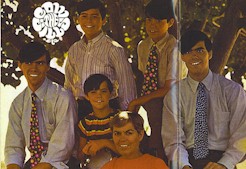
|
|
Over 40 years after its late August 1968 release, Captain Sad And His Ship Of Fools remains a remarkable achievement for any band, let alone one with most members ranging from ages 8 to 20. The Rhode Island family septet's third LP for M-G-M - following 1967's The Cowsills, which included the band's initial breakout hit, "The Rain, The Park And Other Things," and 1968's We Can Fly , which was s partially produced by brothers Bill and Bob and whose title track was the group's second sizable hit—would prove to be one of their finest. In an age when it's not uncommon for bands to spend years in the studio laboring over a single album, it'? difficult to imagine that the meticulously arranged and produced Captain Sad was The Cowsills' third LP release in a single 12-month period.
The album left many fans pondering exactly who was this Captain whose "paper ship was soon to run aground"? Did Bill and Bob Cowsill create a concept album around this fateful character? The LP sleeve implies so, with a single paragraph tying all of Captain Sad's song titles together fairly cohesively. Fortunately, the answer to this and many other questions are answered by Captain Sad coproducer Bob Cowsill. Let's take a selected trip through Captain Sad with Bob himself:
|
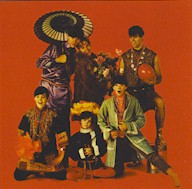
|
|
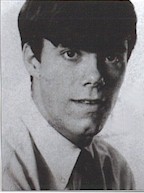
|
|
Captain Sad and his Ship of Fools
Selected track by track with Bob Cowsill.
Captain Sad:
I think the song "Captain Sad" lends itself to thinking Captain Sad was a concept album. Within the song it's conceptual, but we never tried to go in and make a Sgt. Pepper and call it Captain Sad instead. That was just a song that Bill and I wrote.
We can't write or read music. Bill and I would get together with our arrangers and talk. And they would write. We could only help them conceptually. We also got to know the studio musicians pretty well. It was a lot of fun to go into the studio to hear what [arranger Herb Bernstein] had come up with.
Make The Music Flow:
Tony Powers was a great cowriter. He came from the world of show tunes. M-G-M teamed us with cowriters. It was a very interesting experience, but something I never did again, expect with my brother or my wife. But during those New York days, it was fantastic to cowrite with somebody. A lot of times it was lyrical mostly. To this day, I cowrite lyrics. I'm OK with the music — that falls out of my head.
|
|
Indian Lake:
M-G-M brought in a new team to work with us. Our last couple of singles didn't hit the peak that ("The Rain, The Park, And Other Things") did. In [Bill and my] opinion, "Indian Lake" went on to be a really good summer record of an OK song. It's an oddball song. You've got one verse, a chorus ... the whole structure of it is weird. And then they played [the finished record] for us and we just hated it. I'm 18. I'm not gonna like a song like that. "You can make the way the Indians do"? What are you talking about? That and Peter Pan wouldn't fly today.
We weren't running the show, so Bill and I decided to write a better song — we wrote "A Good Day." And we called up M-G-M and scheduled a meeting to play them our new song. "Indian Lake" was already recorded by this point, and we were wondering where they were taking us, in terms of the music. M-G-M took our meeting, and Bill and I went over there with our guitars and sang our little song. They listened, and one of the suits sat back in his chair and said, "Boys, I'm gonna play you a hit record." And he picks the arm up over a record and plays the opening bars of "Indian Lake." And we were like, "OK, we've lost this battle." To add insult to injury, "A Good Day" was used by the American Dairy Association in their commercials; they called it "The Milk Song." We were in those commercials. It was supposed to have made us a lot of money, but it didn't. We were aghast at the compromise we had made artistically, but then we heard Brian Wilson liked it, and that helped us a lot with the credibility issue. We were like, "No, you're kidding!" Nowadays it doesn't matter. But back then having a song in an ad was perceived as selling out.
|
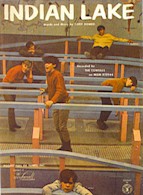
|
|
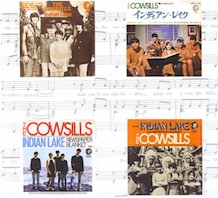
|
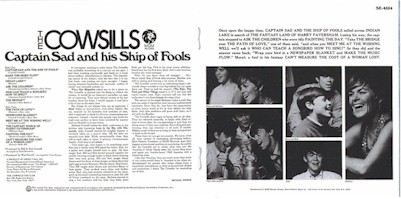
|
|
Ask The Children:
Susan sang that. And look, Bill and I weren't writing songs for Susan or John. Susan was 8, John was 10. Talented little kids, believe me. And I appreciate that more today than I did back then. The songs for Susan and John had to be good and measure up to the rest of the material. "Ask The Children" is really well sung for a kid her age. I think it's amazing — that a kid that young under that pressure could stand in a studio and do that lead vocal, and we could build around such a young voice. And the message was great too. A relative of ["Ask The Children" cowriter] John Wonderling's contacted us and wanted us to know how much our recording of his song meant to them.
Who Can Teach A Songbird How To Sing:
Beautiful, beautiful song! Graham Nash was a cowriter on that. At the time, Crosby, Stills & Nash hadn't happened yet. And it was Nash's name and singing on the demo that got us to cut it. And it was also a rare lead vocal by me. Back then I didn't sing many lead vocals. Bill was the guy 'til he died. He could out-sing me in a wheelchair! He just had it. The rest of us had to spend years of work just to get close to what he could do. I love the time signature shift in that song.
The Bridge:
Mom fell under the same category as Susan and John. It was difficult to find her anything to sing. She was more comfortable in concert. Even though she was a wreck in concert, she was a real wreck in the studio! Even on "The Rain, The Park," she sang with me on the high parts. She wouldn't do it unless I was singing unison with her at the mike. "The Bridge" has a beautifu timeless message that will always, unfortunately, be relevant.
|
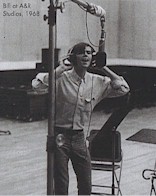
|
|
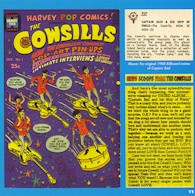
|
|
The Path Of Love:
Great song. John sounds like Wayne Newton. He gave such a good lead vocal for his age! I love everything about this song. In fact, it was so good M-G-M decided to release it as a solo single for John. You listen to John's lead vocal and you think, "This guy's gonna take over," but he has the kind of voice that can only be the lead vocal on a certain type of song. And when he has it, it's the most unbelievable singing I've ever heard. Even to this day, when we hook up, and he's onstage with us, we'll do "The Path Of Love." It's one of the few songs from way back then that we resurrect and perform because it's a beautiful song. When I hear his lead vocal on that now, I hear the singer he was going to become.
Newspaper Blanket:
Another song I got to sing. I was a student at Pace College in NYC. We were living there at the time. And I would jump the subway and head on down to the campus on Staten Island, I think. One day, as I was coming out of the subway, a huge snowstorm rolled in. It was snowing, but it was kinda gorgeous. Kinda Currier & Ives. And I thought, wow, that happened fast. And I cut through a park to Pace College to the building where my class was. And there's this bum on a park bench. Of course, that's nothing unusual. I saw him all the time. But this is a snowstorm, and he's lying on his side on this bench and he's covered with newspapers. People are watching him because it's almost this surreal scene - it's quiet. It's snowing real thick. He's asleep, and he's figured out how he's gonna handle it. And it just affected me. It affects me today to tell the story because it's one of the saddest things I've seen. And I can't to this day . . . Homeless people just tear me apart. I played at a place for about three years called the Boathouse in Santa Monica. I got to know everybody, and they got know me. People who lived under the pier. And I would just give them my tip money all the time.
Anyway, I had the melody going and I lived at 888 8th Avenue. And in that apartment there were also offices where we would write. So we were in the office and a girl named Toni Wine was there. She wrote "A Groovy Kind Of Love" and some other things. She was writing at time in the same area where we were. She heard the melody of "Newspaper Blanket"; we didn't have any words yet. She said, "If you decide not to do anything with that melody, I will!"
Meet Me At The Wishing Well:
That one is memorable to us as a family because it contains Mom's impersonation of Snow White or Cinderella. She's ahh-ing in the background. It's a nice song and melodic, but not as memorable to us as some of the other cuts on the album. Mom gave herself less credit than she deserved. She had a beautiful voice and was better than she thought she was.
Fantasy World Of Harry Faversham:
Look, we were teenaged guys and that song was hilarious to us. Now, when I hear that song to I think, "Oh, my God, what were we doing?" Bill's imitating Snidely Whiplash or whomever he's doing. But the dream part of it, beyond the campiness of it, is a really nice message. That sold us too. We liked the message with the ridiculous way it was being presented. This is the kind of song that, if we did a music video for it, it would be hilarious.
|
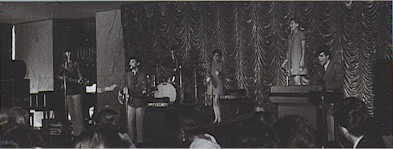
|
|

|
|
Painting The Day:
Really good song that we loved. We didn't write it. It was right in Barry's range. Right in the pocket. He was going to grow into the number 2 singer in the family. I would put Bill first, Barry second, and me third. And John at fourth.
Can't Measure The Cost Of A Woman Lost:
We didn't know who David Gates was at the time — this was a couple of years before Bread. We just thought it was a cool song. Bill did a great job on it. It had a good feel to it. I'd love to ask him if he ever knew about our recording. As I get older, I always wonder what writers think of what we did to their songs. I ponder it all the time.
******************
With a documentary in the works, and several recent tours behind them, The Cowsills are reinventing themselves once more for a new generation. Despite the recent loss of two brothers, Barry and Bill, the remaining Cowsills are still recording, performing, and doing what they do best: harmonizing
Steve Stanley
December, 2008
Los Angeles, CA
steve@thenowpeopie.com
|

|
|
1 CAPTAIN SAD AND HIS SHIP OF FOOLS
(Cowsill-Cowsill) Akbestal Music Inc. (BMI)
2 MAKE THE MUSIC FLOW
(Cowsill-Cowsill-Powars)
Akbestal Music Inc./Little A Music/Unichappell Music Inc.
3. INDIAN LAKE*
(Tony Romeo) EMI Sosaha Music Inc./R2M Music (BMI)
4. ASK THE CHILDREN
(J. Wonderiing~E, Goldfuss-C. Budnick)
Tattersall Music Co. (BMI)
5. WHO CAN TEACH A SONGBIRD HOW TO SING?
(C. Ogerman-S. English-G. Nash)
He!ios Music Co./Marlbus Music inc. (BMI)
6. THE BRIDGE
(John R. Giuck)
Ameropean Music Inc. (ASCAP)
7. THE PATH OF LOVE*
(Tony Romeo) EMI Sosaha Music lnc./R2M Music (BMI)
8 NEWSPAPER BLANKET
(Cowsill-Cowsill) Akbesta! Music Inc. (BMI)
9 MEET ME AT THE WISHING WELL
(CowsUI-Cowslll) Akbesta! Music Inc. (BMI)
10 THE FANTASY WORLD OF HARRY FAVERSHAM
(Victor Miilrose-Devid Hess)
Gil Music Corporation (BMI)
11 PAINTING THE DAY
(William Barberis-Robert Ronga)
Gil Music Corporation (BMI)
12 CAN'T MEASURE THE COST OF A WOMAN LOST
(David Gates) Sony/ATV Tunes LLC (ASCAP)
|
|
13 INDIAN LAKE (Mono)
(Tony Romeo)
EMI Sosaha Music Inc./R2M Music (BMI)
Billboard Pop #10 July 1968
14 NEWSPAPER BLANKET (Mono)
(Cowsill-Cowsill) Akbestal Music Inc. (BMI)
15 POOR BABY (Mono)
(TonyRomeo)
Akbestal Music Inc., EMI Sosaha Music Inc., R2M Music (BMI)
Billboard Pop #44, October 1968
16 MEET ME AT THE WISHING WELL (Mono)
(Cowsill - Cowsill) Akbestal Music inc. (BMI)
17 THE PATH OF LOVE (Mono)*
JOHN COWSILL
(Tony Romeo)
Akbestal Music Inc./EMI Sosaha Music lnc./R2M Music (BMI)
Billboard Pop *132, November 1968
18 CAPTAIN SAD AND HIS SHIP OF FOOLS (Mono)
(Cowsill - Cowsill) Akbestal Music Inc. (BMI)
PRODUCED BY BILL & BOB COWSILL
AND ARRANGED BY HERB BERNSTEIN
except * PRODUCED BY WES FARRELL
AND ARRANGED BY TONY ROMEO
ENGINEERED BY ROY CICALA & VAL VALENTIN
at A&R Studios, New York City
COVER PHOTO BY DeWAYNE DALRYMPLE
|
|
Captain Sad And His Ship Of Fools [M-G-M SE-4554 (Stereo)] was released in August 1968
and charted Billboard Hot 100 #105 in October 1968.
PRODUCED FOR COMPACT DISC BY STEVE STANLEY
LINER NOTES, ART DIRECTION & LAYOUT: STEVE STANLEY
MASTERED BY ALAN BROWNSTEIN
PHOTO RESEARCH: LISA SUTTON
PROJECT ASSISTANCE: BOB COWSILL, WES CONNORS, HERB BERNSTEIN, ELLIOT KENDALL,
DAVID BASH, SHERYL FARBER, ADAM VELASCO, MATT BRISTOW, DAVETIMPERLY, JON ROBERTS,
JIM LASPESA, DENIS JOHNSTON, PAUL ROBINSON, GORDON CARMADELLE,
BOB SAY AND FREAKBEAT RECORDS
|
|













